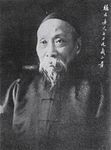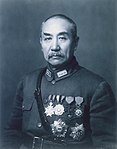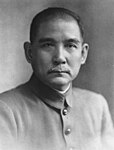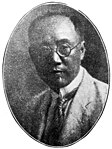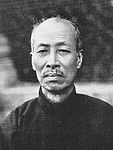1909 Chinese parliamentary election
| |||||||||||||||||||||||||||||||||||||||||||||||||||||||||||||
196 seats (of 200 seats) to the Advisory Council 101 seats needed for a majority | |||||||||||||||||||||||||||||||||||||||||||||||||||||||||||||
|---|---|---|---|---|---|---|---|---|---|---|---|---|---|---|---|---|---|---|---|---|---|---|---|---|---|---|---|---|---|---|---|---|---|---|---|---|---|---|---|---|---|---|---|---|---|---|---|---|---|---|---|---|---|---|---|---|---|---|---|---|---|
| |||||||||||||||||||||||||||||||||||||||||||||||||||||||||||||
 Constitutionalist majority Independent majority Divided between constitutionalists and independents Divided between constitutionalists and revolutionaries No election | |||||||||||||||||||||||||||||||||||||||||||||||||||||||||||||
The 1909 Chinese parliamentary election was an indirect election to the first imperial Advisory Council, a preparatory body of the parliament created under the constitutional reform bought by the late Qing dynasty. It was seen as the first popular election in Chinese history.[1]
Originally 100 members, half of the seats in the council were to be elected by the members of the Provincial Consultative Assemblies, while the other half were appointed by the Emperor. Due to the fact the Provincial Consultative Assembly had not been set up in Sinkiang, the seats were reduced to 98.
Translations with bracketed Chinese text are for reference only.
Electoral system[edit]
The candidates were indirectly elected by members of Consultative Assembly in provinces. The number of candidate each electorate shall vote for was double the delegated seats. Amongst all the supported candidates, half of them would be chosen by the governor as elected members. Appointed members included a certain degree of election features as there were considerable size of eligible members.[1]
Constituencies[edit]
The new Advisory Council only consisted of 196 members, instead of 200 as planned, as Consultative Assembly was not established in Sinkiang, and the number of appointed members shrank to 98 to achieve the balance.
Elected members are as follows:
| Province | Seats | Province | Seats | |
|---|---|---|---|---|
| Zhili | 9 | Shanxi | 5 | |
| Zhejiang | 7 | Fujian | 4 | |
| Jiangsu | 7 | Shaanxi | 4 | |
| Jiangxi | 6 | Yunnan | 4 | |
| Shandong | 6 | Fengtian | 3 | |
| Sichuan | 6 | Gansu | 3 | |
| Anhui | 5 | Guangxi | 3 | |
| Henan | 5 | Heilongjiang | 2 | |
| Hubei | 5 | Jilin | 2 | |
| Hunan | 5 | Guizhou | 2 | |
| Guangdong | 5 | Xinjiang | — |
Appointed members are as follows:
| Constituency | Seats | Constituency | Seats | |
|---|---|---|---|---|
| Government Officials (各部院衙門官) | 32 | Scholars (碩學通儒) | 10 | |
| Princes of Imperial Family (宗室王公世爵) | 14 | Large Taxpayers (納稅多額) | 10 | |
| Princes of Feudatories (外藩王公世爵) | 14 | Descendants of Emperor (宗室覺羅) | 6 | |
| Nobility of Manchu and Han (滿漢世爵) | 12 |
Result[edit]
The constitutionalists, who advocated constitutional monarchy in Qing, secured a majority in the Advisory Council. The revolutionaries on the other hand, despite banned by the authorities, won a few seats.[2][3] The party membership is only estimation as political party system was immature at the time. Some members resigned during the session and the vacancies were filled according to the precedence list, which their membership is not reflected here.
| Political party | Elected | Appointed | Total | |
|---|---|---|---|---|
| Continuous Constitutionalism Association (憲政維持進行會) | 38 | 37 | 75 | |
| Xinhai Club (辛亥俱樂部) | 4 | 7 | 11 | |
| Chinese Empire Reform Association | 10 | 0 | 10 | |
| Political Science Club (政學會) | 1 | 4 | 5 | |
| Preparative Constitutionalism Association (預備立憲公會) | 3 | 2 | 5 | |
| Brotherhood of Petition for Parliament (國會請願同志會) | 5 | 0 | 5 | |
| Joint Association of Provincial Consultative Assemblies (各省諮議局聯合會) | 3 | 0 | 3 | |
| Guangdong Autonomous Chamber of Commerce (粵商自治會) | 1 | 0 | 1 | |
| Preparative Constitutionalism Association of Guizhou (貴州憲政預備會) | 1 | 0 | 1 | |
| 66 | 50 | 116 | ||
| Tongmenghui | 4 | 3 | 7 | |
| Association for Guizhou Autonomy (貴州自治學社) | 1 | 0 | 1 | |
| 5 | 3 | 8 | ||
| 27 | 45 | 72 | ||
| Vacant | 2 | 2 | 4 | |
| Total | 100 | 100 | 200 | |
Detailed results[edit]
| Zhili | Zhejiang | Jiangsu | Jiangxi | Shandong | Sichuan | Anhui | Henan | Hunan | Shanxi | Yunnan | ||
|---|---|---|---|---|---|---|---|---|---|---|---|---|
| Continuous Constitutionalism Association | 6 | 1 | 4 | 2 | 2 | 3 | 1 | 2 | 1 | |||
| Chinese Empire Reform Association | 2 | 2 | 2 | 1 | 2 | |||||||
| Xinhai Club | 1 | 2 | 1 | |||||||||
| Political Science Club | 1 | |||||||||||
| Preparative Constitutionalism Association | 1 | 1 | 1 | |||||||||
| Brotherhood of Petition for Parliament | 1 | 1 | 1 | 1 | 1 | |||||||
| Joint Association of Provincial Consultative Assemblies | 1 | 2 | ||||||||||
| Tongmenghui | 1 | 2 | 0 | 1 | ||||||||
| Independents | 1 | 2 | 1 | 1 | 2 | 2 | 3 | 1 | 1 | |||
| Total | 9 | 7 | 7 | 6 | 6 | 6 | 5 | 5 | 5 | 5 | 4 | |
| Hubei | Guangdong | Fujian | Shaanxi | Fengtian | Gansu | Guangxi | Guizhou | Heilongjiang | Jilin | ||
|---|---|---|---|---|---|---|---|---|---|---|---|
| Continuous Constitutionalism Association | 4 | 4 | 2 | 1 | 3 | 2 | |||||
| Chinese Empire Reform Association | 1 | ||||||||||
| Guangdong Autonomous Chamber of Commerce | 1 | ||||||||||
| Preparative Constitutionalism Association of Guizhou | 1 | ||||||||||
| Association for Guizhou Autonomy | 1 | ||||||||||
| Independents | 1 | 4 | 2 | 2 | 2 | 2 | |||||
| Total | 5 | 5 | 4 | 4 | 3 | 3 | 3 | 2 | 2 | 2 | |
| Officials | Imperial Prince | Feudatory Prince | Nobility | Scholars | Taxpayers | Emperor's Descendants | ||
|---|---|---|---|---|---|---|---|---|
| Continuous Constitutionalism Association | 14 | 6 | 3 | 6 | 6 | 3 | ||
| Xinhai Club | 6 | |||||||
| Political Science Club | 2 | 1 | 1 | |||||
| Preparative Constitutionalism Association | 2 | |||||||
| Tongmenghui | 1 | 2 | ||||||
| Independents | 9 | 8 | 13 | 9 | 1 | 2 | 3 | |
| Total | 32 | 14 | 14 | 12 | 10 | 10 | 6 | |

